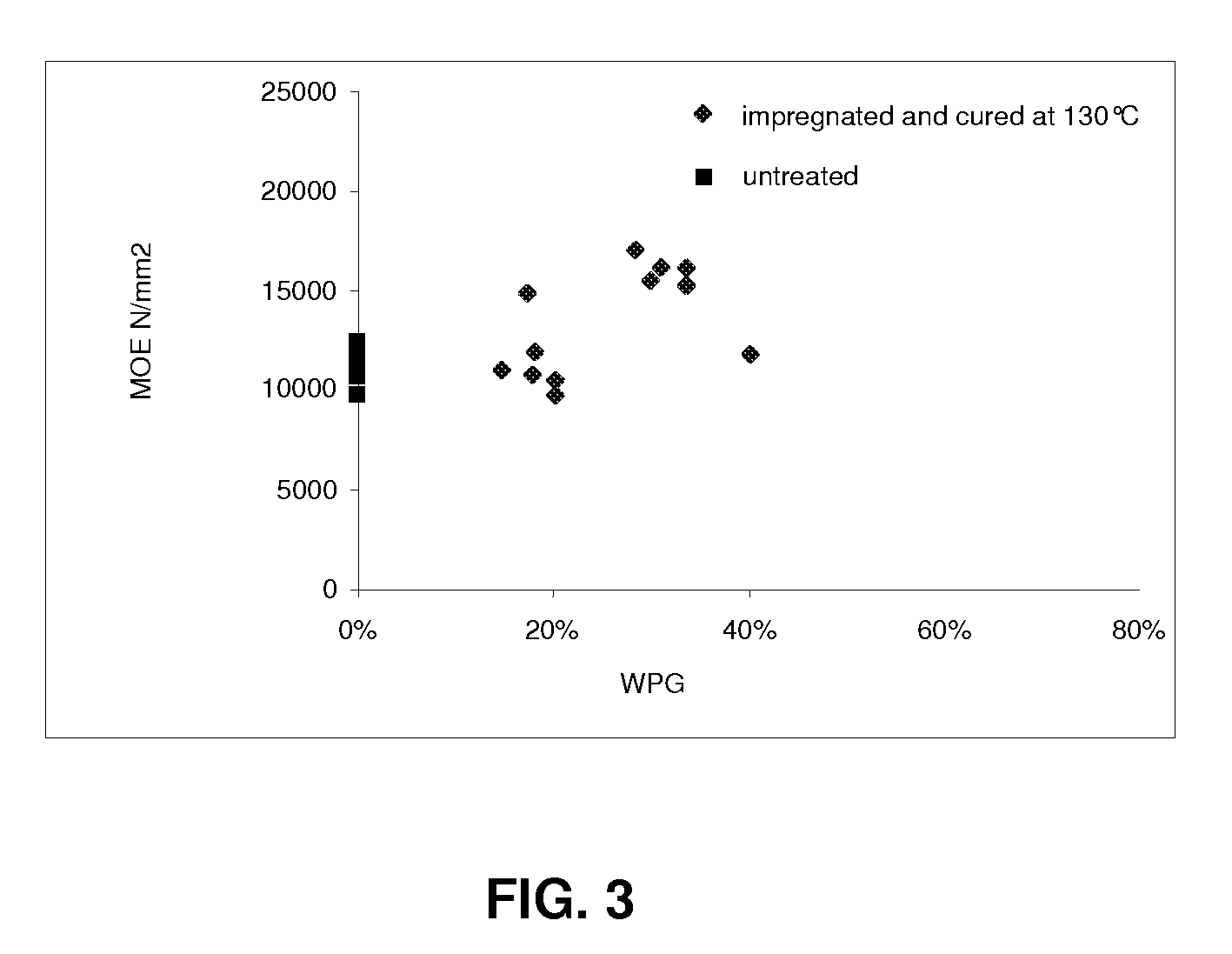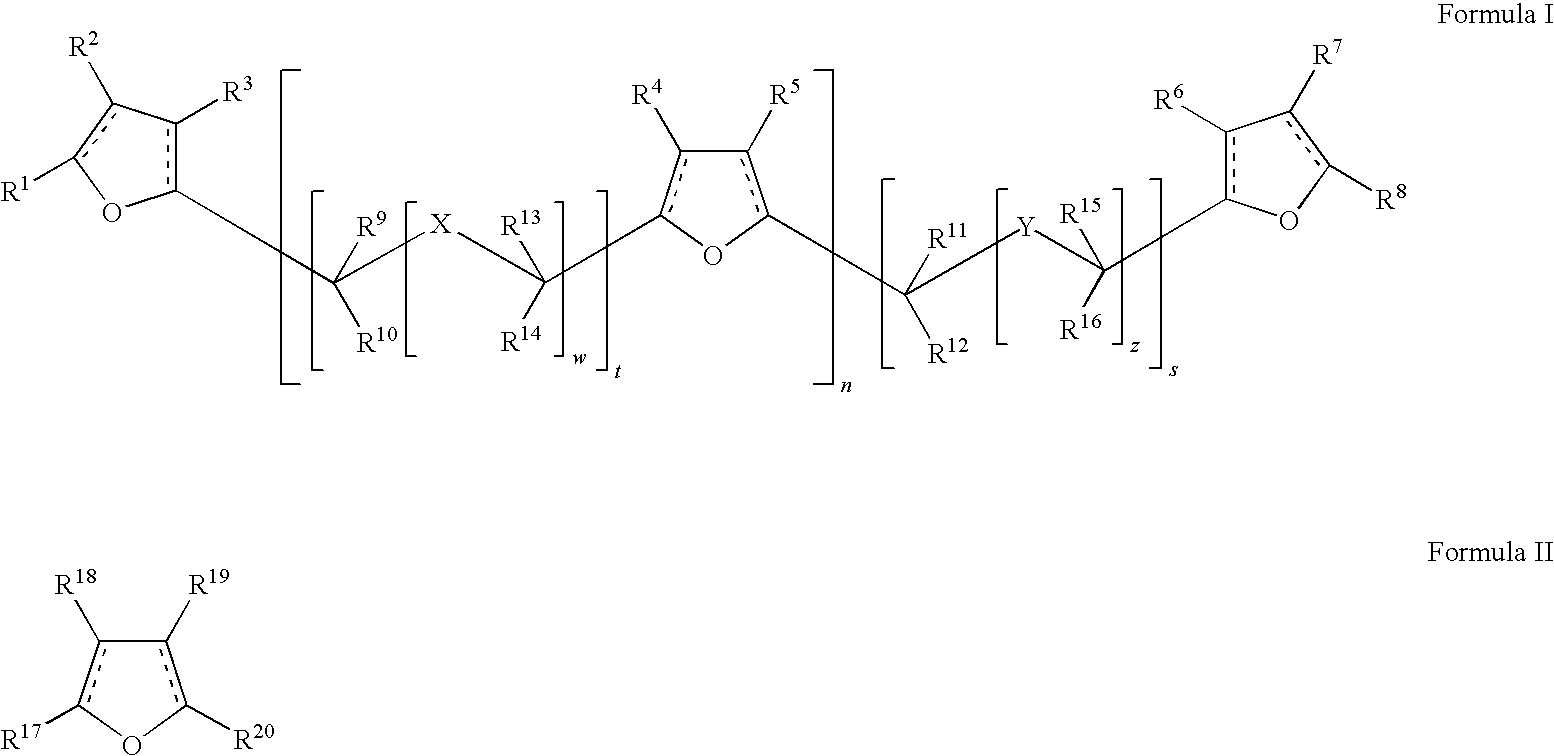Method for modifying wood and wood thereby obtained
a technology of modifying method and wood, applied in the field of modifying method of wood and wood, can solve the problems of toxicity of most of these preservatives to organisms in the environment, problem of disposal at the end of life, and utilization of furan compounds, etc., to achieve the effect of improving storage stability
- Summary
- Abstract
- Description
- Claims
- Application Information
AI Technical Summary
Benefits of technology
Problems solved by technology
Method used
Image
Examples
example 1
[0205]In this example Scots Pine Sapwood was treated with the following substituted furan compounds according to the invention: 2,5-bis(hydroxymethyl)furan, 5-hydroxymethyl-2-furancarboxaldehyde, 5-hydroxymethyl-2-furfurylamine, 5-methyl-2-furfuryl alcohol, 5-hydroxymethyl-α-(methyl)furfuryl alcohol. These furan compounds were formulated into aqueous impregnation compositions according to Table 1.
TABLE 1ImpregnationcompositionFuran compoundSolventCatalyst12,5-H2OMaleic anhydridebis(hydroxymethyl)furan(77 wt %)(1 wt %)(22 wt %)25-hydroxymethyl-2-H2OMaleic anhydridefurancarboxaldehyde(77 wt %)(1 wt %)(22 wt %)35-hydroxymethyl-2-H2OMaleic anhydridefurfurylamine (22 wt %)(77 wt %)(1 wt %)45-methyl-2-furfuryl alcoholMeOHMaleic anhydride(22 wt %)(77 wt %)(1 wt %)55-hydroxymethyl-α-H2OMaleic anhydride(methyl)furfuryl alcohol(77 wt %)(1 wt %)(22 wt %)
[0206]Five batches of Scots pine sapwood were impregnated with impregnation compositions 1, 2, 3, 4 or 5 in an impregnation vessel. The wood w...
example 2
[0208]In a second example pine sapwood was impregnated and reacted with aqueous mixtures of 2,5-bis(hydroxymethyl)furan (BHMF), 2,3,5-tris(hydroxymethyl)furan (THMF), 2,2′-hydroxymethyldifurylmethane (HMDM) and condensation products of BHMF, THMF and HMDM. The water-soluble furan resin thus contained disubstituted, trisubstituted and polysubstituted furan compounds.
[0209]A method to prepare this resin includes the acid catalyzed hydroxymethylation of furfuryl alcohol (FA). Such method is presented below. In this method, a reactor was charged with FA, pF (paraformaldehyde) and adipic acid. The quantities used are shown in Table 3.
TABLE 3Total charge of reactants for phase IWtWtMW(kg)(%)Moles(mol / g)FA29861.193037.798.10pF174.835.905820.830.03Adipic acid14.162.9199.90146.14Total502.6100Molar ratio (pF / FA) = 1.9
[0210]Then the reactor was purged with nitrogen and heated to 117° C. Some pressure was added to the reactor with nitrogen. The free formaldehyde was analyzed at 3 h of reaction ...
example 3
[0224]In this example Scots Pine Sapwood was treated with compounds according to the invention having formula II′ or formula V. Compounds with formula II are listed in table 6. Compounds with formula V are listed in table 7. These furan compounds were formulated into impregnation compositions similar as explained in example 1. Prior to impregnation the compounds were diluted in an appropriate solvent. After impregnation and curing the wood showed a positive WPG which indicates that the compounds in table 6 and 7 reacted with the wood upon curing at temperatures at least higher than 70° C.
TABLE 6CompoundR17R18R19R20 1—CH2OH—H—H—CH2OH2,5-bis(hydroxymethyl)furan 2—CH2OH—CH2OH—H—CH2OH2,3,5-tris(hydroxymethyl)furan 3—CH2OH—H—H—CH35-methyl-2-furfuryl alcohol 4—CH2OH—CH2OH—H—CH33-hydroxymethyl-5-methyl-2-furfurylalcohol 5—C(═O)H—H—H—CH2OH5-hydroxymethyl-2-furancarboxaldehyde 6—C(═O)H—CH2OH—H—CH2OH3,5-hydroxymethyl-2-furancarboxaldehyde 8—C(═O)H—H—CH2OH—CH2OH4,5-hydroxymethyl-2-furancarboxa...
PUM
| Property | Measurement | Unit |
|---|---|---|
| temperature | aaaaa | aaaaa |
| temperature | aaaaa | aaaaa |
| temperature | aaaaa | aaaaa |
Abstract
Description
Claims
Application Information
 Login to View More
Login to View More - R&D
- Intellectual Property
- Life Sciences
- Materials
- Tech Scout
- Unparalleled Data Quality
- Higher Quality Content
- 60% Fewer Hallucinations
Browse by: Latest US Patents, China's latest patents, Technical Efficacy Thesaurus, Application Domain, Technology Topic, Popular Technical Reports.
© 2025 PatSnap. All rights reserved.Legal|Privacy policy|Modern Slavery Act Transparency Statement|Sitemap|About US| Contact US: help@patsnap.com



